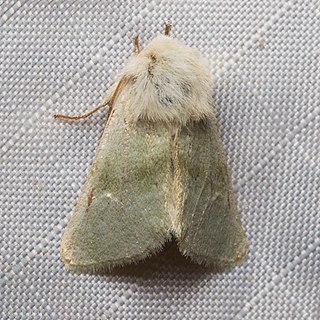
Pope Miltiades, also known as Melchiades the African, was the bishop of Rome from 311 to his death on 10 or 11 January 314. It was during his pontificate that Emperor Constantine the Great issued the Edict of Milan (313), giving Christianity legal status within the Roman Empire. The pope also received the palace of Empress Fausta where the Lateran Palace, the papal seat and residence of the papal administration, would be built. At the Lateran Council, during the schism with the Church of Carthage, Miltiades condemned the rebaptism of apostatised bishops and priests, a teaching of Donatus Magnus.

Mythimna pallens, the common wainscot, is a moth of the family Noctuidae distributed throughout the Palearctic realm from Ireland in the west, through Europe to Central Asia and Amur to the Kuriles in the east. The species was first described by Carl Linnaeus in his 1758 10th edition of Systema Naturae.

Orchis is a genus in the orchid family (Orchidaceae), occurring mainly in Europe and Northwest Africa, and ranging as far as Tibet, Mongolia, and Xinjiang. The name is from the Ancient Greek ὄρχις orchis, meaning "testicle", from the appearance of the paired subterranean tuberoids.

The Broom Moth(Ceramica pisi) is a moth of the family Noctuidae. It is found in all of Europe, East across the Palearctic to Siberia and the Russian Far East. In the north, it is found far beyond the Arctic Circle and in the south to northern Spain. In the Alps, it is found at heights of up to 2,000 metres.

Pachypasa is a genus of moths in the family Lasiocampidae. The genus was erected by Francis Walker in 1855.

Hypocala deflorata is a moth of the family Erebidae. It was first described by Johan Christian Fabricius in 1794. It is widespread from India, Sri Lanka to Africa and to Australia and many Pacific islands. Records include China, Borneo, Queensland, Vanuatu, New Caledonia, Rotuma, Fiji, Samoa, Hawaii, Norfolk Island and New Zealand.
Pleiomorpha eumeces is a moth of the family Gracillariidae. It is known from South Africa.

Azygophleps is a genus of moths belonging to the family Cossidae.
Azygophleps pallens is a moth in the family Cossidae. It is found in Sierra Leone, Uganda, Nigeria, Cameroon, Kenya and Sudan.
Ancylodes pallens is a species of snout moth in the genus Ancylodes. It was described by Émile Louis Ragonot in 1887 and is known from Iran, Iraq, Spain, Croatia, Greece, Russia, Kazakhstan and North Africa. It is a very rare immigrant to southern Great Britain.
Lamoria pallens is a species of snout moth. It is found in South Africa.
Dindica pallens is a moth of the family Geometridae first described by Hiroshi Inoue in 1990. It is found on the Philippines.
Siccia pallens is a moth in the family Erebidae. It was described by George Hampson in 1918. It is found in Uganda.
Pharga pallens is a species of moth in the family Erebidae. It was first described by William Barnes and James Halliday McDunnough in 1911 and it is found in North America.

Nocloa pallens is a species of moth in the family Noctuidae. It is found in North America.

Chrysopoloma restricta is a moth in the genus Chrysopoloma. It is in the family Chrysopolominae.

Chrysopoloma isabellina, or the Isabel’s slug moth. It is a moth in the genus Chrysopoloma. It’s in the family Chrysopolominae.

Chrysopolominae is a subfamily of moths in the family Limacodidae. The type genus of this subfamily is Chrysopoloma. Chrysopolominae was originally a family (Chrysopolomidae) under the superfamily Zygaenoidea, consisting of two subfamilies, including about 30 species distributed in Africa, but in other newer documents, this family was downgraded and became It is a subfamily under Limacodidae, which belongs to the superfamily of Zygaenoidea, and the two subfamilies originally under Chrysopolominae were merged to become the synonym of Chrysopolominae called Ectropinae.
Chrysopoloma varia is a moth in the genus Chrysopoloma. It is in the family Chrysopolominae.

Chrysopoloma is a genus of moths in the family Chrysopolominae. It is the type genus in the family.











